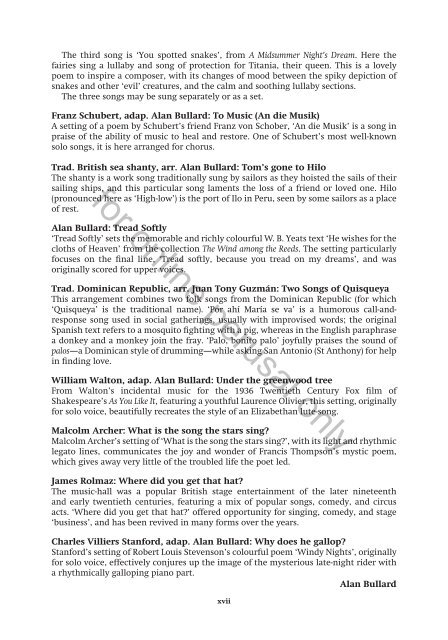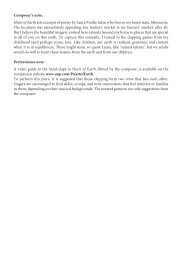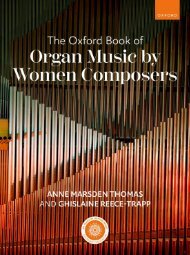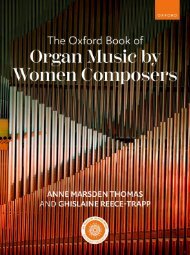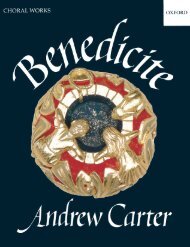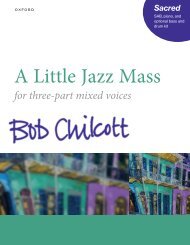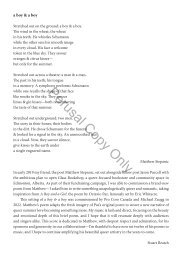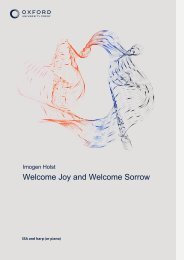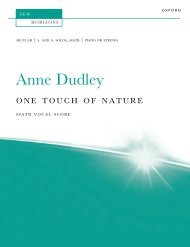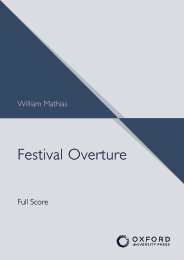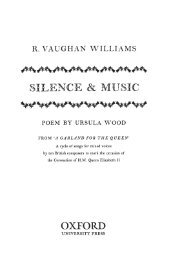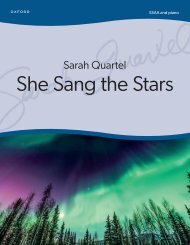Oxford Book of Flexible Choral Songs
The Oxford Book of Flexible Choral Songs is the perfect resource for secular choirs and singing groups who like the flexibility to perform songs in a range of combinations from unison to SATB. Each piece may be performed by a mixed choir, but is also presented with flexible scoring options, clearly explained throughout, enabling performance by various combinations of singers, including upper voices or men's voices alone. As well as new arrangements of existing repertoire, the collection also features newly commissioned original works, specially written for flexible forces.
The Oxford Book of Flexible Choral Songs is the perfect resource for secular choirs and singing groups who like the flexibility to perform songs in a range of combinations from unison to SATB. Each piece may be performed by a mixed choir, but is also presented with flexible scoring options, clearly explained throughout, enabling performance by various combinations of singers, including upper voices or men's voices alone. As well as new arrangements of existing repertoire, the collection also features newly commissioned original works, specially written for flexible forces.
Create successful ePaper yourself
Turn your PDF publications into a flip-book with our unique Google optimized e-Paper software.
The third song is ‘You spotted snakes’, from A Midsummer Night’s Dream. Here the<br />
fairies sing a lullaby and song <strong>of</strong> protection for Titania, their queen. This is a lovely<br />
poem to inspire a composer, with its changes <strong>of</strong> mood between the spiky depiction <strong>of</strong><br />
snakes and other ‘evil’ creatures, and the calm and soothing lullaby sections.<br />
The three songs may be sung separately or as a set.<br />
Franz Schubert, adap. Alan Bullard: To Music (An die Musik)<br />
A setting <strong>of</strong> a poem by Schubert’s friend Franz von Schober, ‘An die Musik’ is a song in<br />
praise <strong>of</strong> the ability <strong>of</strong> music to heal and restore. One <strong>of</strong> Schubert’s most well-known<br />
solo songs, it is here arranged for chorus.<br />
Trad. British sea shanty, arr. Alan Bullard: Tom’s gone to Hilo<br />
The shanty is a work song traditionally sung by sailors as they hoisted the sails <strong>of</strong> their<br />
sailing ships, and this particular song laments the loss <strong>of</strong> a friend or loved one. Hilo<br />
(pronounced here as ‘High-low’) is the port <strong>of</strong> Ilo in Peru, seen by some sailors as a place<br />
<strong>of</strong> rest.<br />
for online perusal only<br />
Alan Bullard: Tread S<strong>of</strong>tly<br />
‘Tread S<strong>of</strong>tly’ sets the memorable and richly colourful W. B. Yeats text ‘He wishes for the<br />
cloths <strong>of</strong> Heaven’ from the collection The Wind among the Reeds. The setting particularly<br />
focuses on the final line, ‘Tread s<strong>of</strong>tly, because you tread on my dreams’, and was<br />
originally scored for upper voices.<br />
Trad. Dominican Republic, arr. Juan Tony Guzmán: Two <strong>Songs</strong> <strong>of</strong> Quisqueya<br />
This arrangement combines two folk songs from the Dominican Republic (for which<br />
‘Quisqueya’ is the traditional name). ‘Por ahí María se va’ is a humorous call-andresponse<br />
song used in social gatherings, usually with improvised words; the original<br />
Spanish text refers to a mosquito fighting with a pig, whereas in the English paraphrase<br />
a donkey and a monkey join the fray. ‘Palo, bonito palo’ joyfully praises the sound <strong>of</strong><br />
palos—a Dominican style <strong>of</strong> drumming—while asking San Antonio (St Anthony) for help<br />
in finding love.<br />
William Walton, adap. Alan Bullard: Under the greenwood tree<br />
From Walton’s incidental music for the 1936 Twentieth Century Fox film <strong>of</strong><br />
Shakespeare’s As You Like It, featuring a youthful Laurence Olivier, this setting, originally<br />
for solo voice, beautifully recreates the style <strong>of</strong> an Elizabethan lute-song.<br />
Malcolm Archer: What is the song the stars sing?<br />
Malcolm Archer’s setting <strong>of</strong> ‘What is the song the stars sing?’, with its light and rhythmic<br />
legato lines, communicates the joy and wonder <strong>of</strong> Francis Thompson’s mystic poem,<br />
which gives away very little <strong>of</strong> the troubled life the poet led.<br />
James Rolmaz: Where did you get that hat?<br />
The music-hall was a popular British stage entertainment <strong>of</strong> the later nineteenth<br />
and early twentieth centuries, featuring a mix <strong>of</strong> popular songs, comedy, and circus<br />
acts. ‘Where did you get that hat?’ <strong>of</strong>fered opportunity for singing, comedy, and stage<br />
‘business’, and has been revived in many forms over the years.<br />
Charles Villiers Stanford, adap. Alan Bullard: Why does he gallop?<br />
Stanford’s setting <strong>of</strong> Robert Louis Stevenson’s colourful poem ‘Windy Nights’, originally<br />
for solo voice, effectively conjures up the image <strong>of</strong> the mysterious late-night rider with<br />
a rhythmically galloping piano part.<br />
Alan Bullard<br />
xvii


